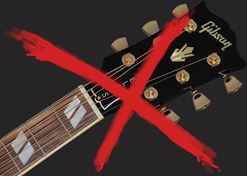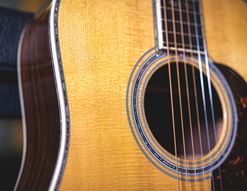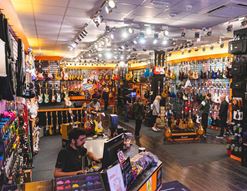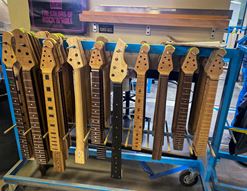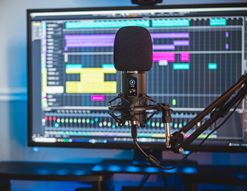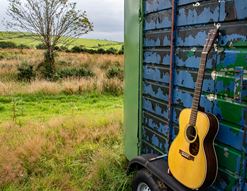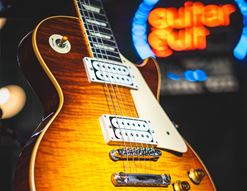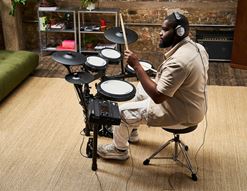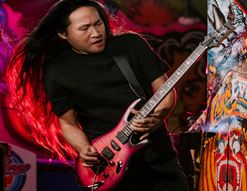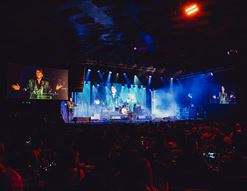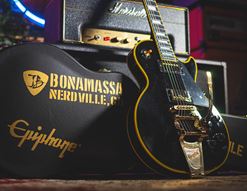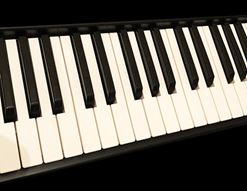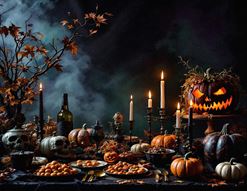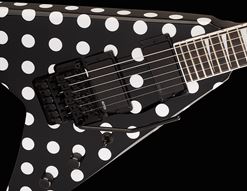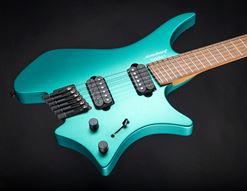Do you ever come across a musician or a band and feel like you need to tell the world about them? Even if they appeared decades in the past? Maybe that makes it even more important to share their story? Particularly if they are no longer with us: I don’t know why it is, but we want to make sure everybody knows how great they were, so that their memory isn’t forgotten in the past.
This happened to me recently, about a player whom I happen to think is both incredible and underappreciated. He’s from before my time, and he was also relatively local to me and indeed us at the guitarguitar HQ.
So it’s high time I shared some love for John McGeoch. If you’re into inventive, interesting and unique players, you’ll want to know more too…
Who Was John McGeoch?
John McGeoch was a Scottish guitarist. He was born in Greenock, a town on the river Clyde around 20 miles West of Glasgow. McGeoch went to art school in Manchester and ended up befriending people in the local music scene. This led to John joining Howard Devoto’s band Magazine, whose sound John instantly expanded and deepened.
During this period, he finished his art degree and also did session work, including with Visage, which gave him an unexpected hit album. John contributed guitar and also, rather excellently, saxophone to the record. McGeoch was with Magazine for three albums before an offer from another band arrived that he could not say no to…
Who Did John Play For?
Most music fans will know John McGeoch as perhaps the most significant and influential guitarist for Siouxsie and the Banshees. He was a Banshee between 1980 and 1982, which doesn’t sound like a long time, but he recorded three seminal albums with them: Kaleidoscope, Juju and A Kiss in the Dreamhouse. He was replaced by none other than Robert Smith of The Cure.
After leaving the Banshees, McGeoch started a band called The Armoury Show, which featured a few members from The Skids. The Armoury Show released one album - Waiting For the Floods - but didn’t catch on. John was an in-demand session player too, and played on records for artists such as Peter Murphy, Tina Turner, Gen X and The Skids at this point.
McGeoch’s other high-profile gig was in Public Image Ltd. Joining in 1986, recording two albums and touring until 1992, John was actually the second-longest serving member of the band at that point, aside from John Lydon. Who did he take over from? Steve Vai!
John’s Guitar Style
John McGeoch had a very cool and unique guitar style, which influenced a huge number of artists including Johnny Marr, Radiohead and John Frusciante. Let me breakdown a few of his choices:
Keep it clean: For his Magazine and Banshees periods, John played primarily with a clean tone, using a combination of amps to get a blend he preferred. Later periods saw him adding on more gain to get an arena rock sound, but a great deal of his most celebrated guitar work is clean and effected.
Pioneering use of flanger effect: John frequently sculpted his sound with an MXR flanger pedal which he kept on a modified mic stand. From subtle washes to alien burbles and jet engine sweeps, he got a huge amount of mileage from this single pedal, which he supplemented with a smattering of other effects.
Play Parts: John was a supportive player rather than a traditional ‘lead guitarist’, but that didn’t make his playing any less dazzling, nor easier to get under one’s fingers! Just try learning all of Spellbound and then playing it at full speed without any errors and you’ll better understand the command he had over his instrument.
Ignore the chord progression: What I’ve found interesting about John’s parts is how often they stray from the fundamental chords of the song. He often allowed the bass to determine a song’s basic harmonic structure, and he’d build his parts around harmony and counterpoint, and sometimes even straying from the foundation altogether.
Halloween is a good example of this, and it also contains one of the most muscle-popping left hand chords I’ve ever had the challenge to have to learn! There are ways to cheat around this type of thing, but I’m pretty sure John would’ve tried the easier ways and rejected them in favour of what sounded best. The point is, this arpeggio doesn’t really explain the harmonic changes of the chords; instead, it’s a gossamer of notes that sit across the chord changes, which change musical context as the bass notes under them change.
Seventh chords: seventh chords were huge in McGeoch’s playing. We’ve seen examples already in both Spellbound and Halloween, but that ‘backwards triangle’ shape (that’s certainly how I see it!) shows up often in his parts. Whether played as arpeggios (Painted Bird for example) or as shrieked ‘panic chords’ (the main riff to Halloween), those seventh chords are a big staple in McGeoch’s sound.
Light and shade: Lots of John’s parts make full use of the guitar fingerboard, including open strings and harmonics. This allows for plenty of colour and texture in his playing, as evidenced in a song like Happy House. His iconic melodic riff is in the 12th fret octave position; the verses are well-spaced arpeggios (those 7th chords again!), and there is a lovely natural harmonics part too, which replaces the arpeggios during some verse parts.
Layering: from his famous Banshees work to his playing with PiL on songs like The Body, McGeoch was great at orchestrating combinations of parts that all contributed to an accumulated sound. He seemed to be able to see the full picture of the song, and fill in the light and shade accordingly.
John McGeoch Guitar Gear
- Yamaha SG is the guitar most closely tied to him
- Combo amps used in stereo
- 0.60mm orange Tortex fin-shaped picks
- MXR Flanger, mounted on his mic stand with a remote foot switch
Post punk and alternative fans will forever love the Yamaha SG thanks to McGeoch’s use of them throughout the hottest years of his career. He went for the SG-1000 model, and used two Tobacco Sunburst models throughout his time with Magazine and Siouxsie and the Banshees. This was an influential choice: the Yamaha SG is now seen as a definitive post-punk/new wave guitar, and fans such as John Frusciante (Red Hot Chili Peppers) have bought SGs in tribute to McGeoch.
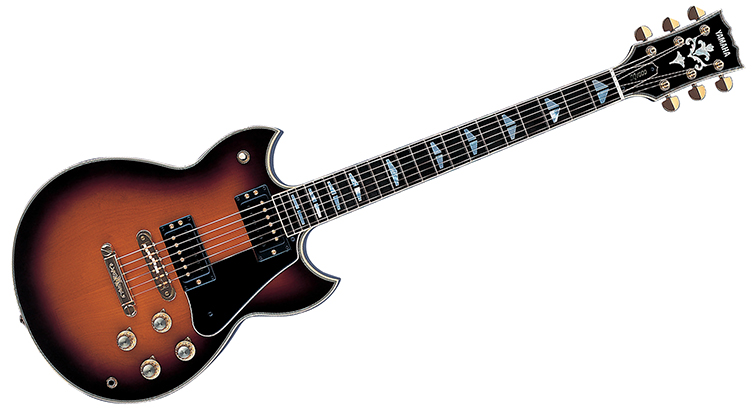
As mentioned earlier, John’s classic sound tended to stick to cleaner tones for the most part. He began with a Roland JC120 Jazz Chorus (the pre-eminent post punk amp!) but soon combined this with a Marshall MV50 combo. He used these in stereo and, as I understand it, going slightly more drive and ‘kick’ from the Marshall alongside the clean definition of the Jazz Chorus.
The big talking point, of course, is the flanger. The one to go for is the MXR M117R Flanger (yep, the Van Halen ‘Unchained’ one!) for that authentic texture and sweep. John put his on a customised mic stand and hooked up a footswitch for it. This allowed him to make instant changes to the controls: given how wide-ranging the sounds can be, this was both a clever and inspired idea.
On top of those, he used an MXR Dynacomp on and off (for bringing out blasts of feedback more easily) and a Yamaha E1005 analogue delay. In terms of picks, it was a tricky thing for me to find info on, but I did come across one tip…In the Kickstarter campaign for a forthcoming documentary on McGeoch, one of the perks was some of John’s lightly used guitar picks. All of them were Dunlop 0.60mm Tortex fins-shaped ones, so that might be worth a little bit of experimentation if you try a few of those!
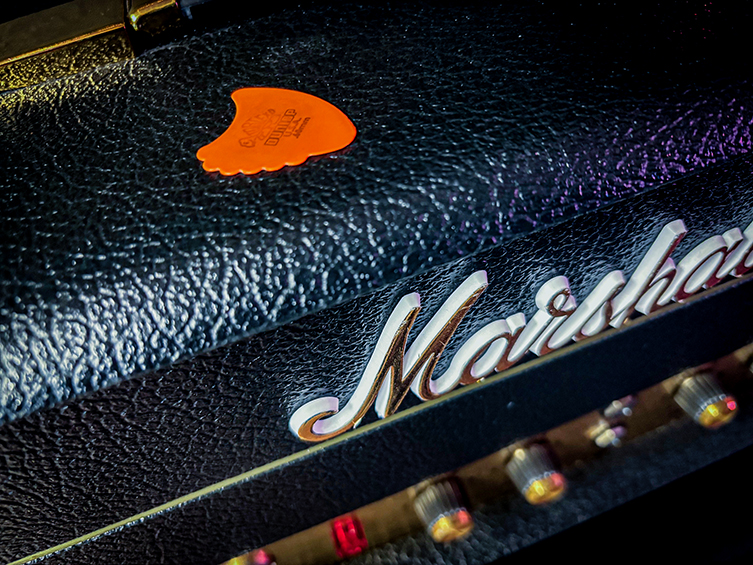
Later years saw John expand on pretty much everything (Washburns and Carvin guitars for Pil, more pedals, Marshall JCM800), but that’s the classic setup for his most famous sound.
Here’s a roundup of the gear:
- Yamaha SG-1000 Tobacco Sunburst (x2)
- Roland JC120 Jazz Chorus
- Marshall MV50
- MXR M117R Flanger
- MXR Dynacomp
- Yamaha E1005 Analogue Delay
- Ernie Ball Super Slinky 9-42 strings
- Dunlop Tortex 0.60mm fin picks
John’s Legacy
John died in his sleep in 2004 at the young age of 48. There’s a lot more to his story, which I don’t have space for and so for that, I’d highly recommend reading Rory Sullivan-Burke’s excellent biography on him called The Light Pours Out of Me. It puts John’s art into context, framing it as the innovative and colourful set of sonic canvasses that it was. He remains highly regarded and influential throughout every subsequent generation of alternative guitarist who has come along since. Here’s what some of his peers have said about John, quoted from Sullivan-Burke’s book…
PETER HOOK (Joy Division, New Order)
“I admired him as a man, I admired him as a player. He’s done some fantastic work and he’s left a wonderful legacy, hasn’t he? The groups that he worked with, fucking hell, they’re legends, aren’t they?”
JOHN FRUSCIANTE (Red Hot Chili Peppers)
“Hearing somebody who understands it so well from the start of their career shows what I believe to be true artistic confidence, and you can’t get that by trying to make people see how confident you are - you have to just be that way inside yourself, and really appreciate the colour and the feeling that music produces.”
STEVE ALBINI (producer for Nirvana and The Pixies)
“I admired and sometimes emulated John McGeoch, though I don’t think I ever had direct interaction with him. In particular, I liked the way that his guitar played abstractions of the music rather than the structure of the music. He could play away from the song and let the listener figure out how it fit in”
JOHNNY MARR (The Smiths)
“As the years have gone on and I’ve made my own records, I’m sometimes reminded ofJohn McGeoch’s influence on my playing. If anything, the passing of time has served to prove just what an impressive musician John McGeoch really was.”
ED O’BRIEN (Radiohead)
“His playing and contribution to Magazine was so good, but I really think he hit his stride with the Banshees, and Juju for me was the epicentre of his playing…so, so good.”
RODDY FRAME (Aztec Camera)
“His guitar parts were a signpost to beyond punk for any guitarists wishing to progress. Never naff or self-indulgent. Never improvised. It’s something he brought with him to the Banshees and PiL. A style that wasn’t rooted in the blues. It was edgy and audacious and playful.”
STUART BRAITHWAITE (Mogwai)
“John McGeoch was the best post-punk guitarist. He played like no one else, totally distinct and with unyielding imagination. I hear his influence everywhere to this day. A total legend.”
STEVEN SEVERIN (Siouxsie and the Banshees bassist)
“Things were never the same once we had lost John. For one thing, the whole dynamic was irrevocably changed as from then on it became the three of us plus the new guy(s). The intense pursuit of excellence, that drive and commitment, the hours and hours take their toll. It was all too much. P.S. Don’t think I mentioned? BEST. GUITARIST. EVER.


